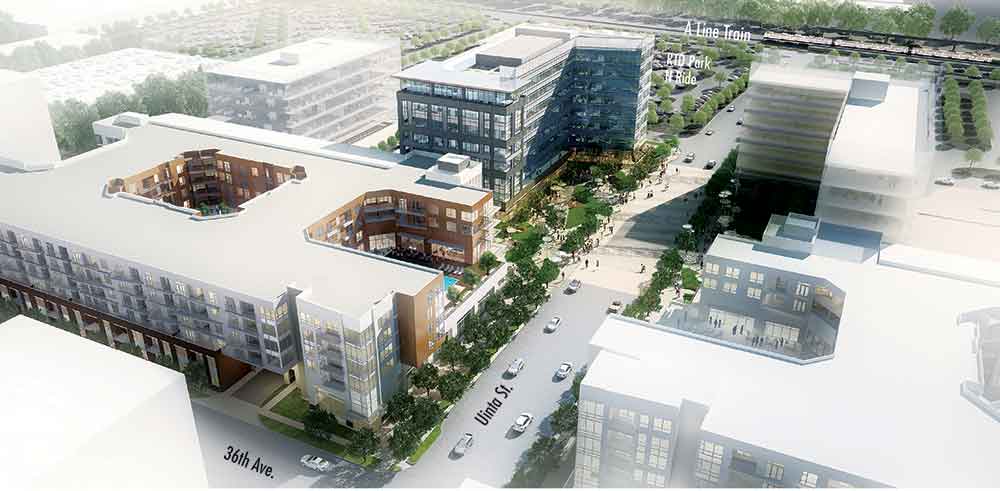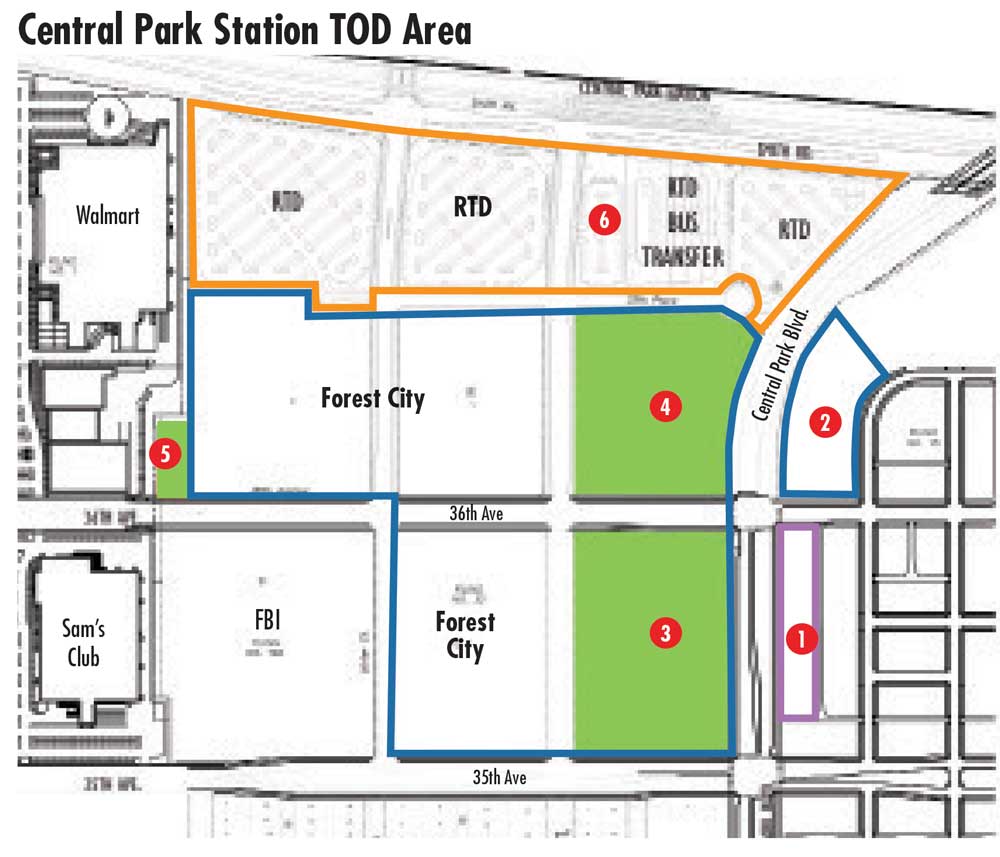
Rendering of future transit oriented development at the Central Park Station. The buildings on the right (east) side of Uinta are currently being planned. The buildings on the left side of Uinta (west) are renderings of what may be built in the future. That land has not yet been sold by Forest City to a developer.
Editor’s Note: This is the second in a series of three articles prepared by the Front Porch detailing development activity in and around Stapleton-area transit-oriented development (TOD) sites. TOD is a term used to describe dense, walkable, mixed-use urban development around high-frequency transit stations. TOD is a key element of the city’s economic development strategy. The November Front Porch described new development planned at the Anschutz Medical Campus south of the Fitzsimons Parkway light rail station. The January issue will present information about the bus rapid transit (BRT) system planned for Colfax and early efforts by Denver to simulate TOD at BRT stops while preserving small businesses and existing affordable housing.
Apparently, it takes a real train, not a promised one, to stimulate investment at a transit-oriented development (TOD) site. That seems to be th story at Stapleton’s Central Park Station site. RTD’s University of Colorado A Line commuter rail train started running in April and now development of the 50-plus areas of vacant land south of the station is showing the first signs of getting underway after a long period of dormancy.

Here’s a rundown on current activities at the Central Park Blvd. TOD:
1.) Central Park Blvd. Townhomes. Construction began at the end of October on this 40-unit, affordable for-sale project by the Northeast Denver Housing Center (NDHC). The project is 100 percent pre-sold with the first tenants projected to move in late next year. The units are similar in appearance to NDHC’s other Stapleton projects such as the Spruce Townhomes on MLK west of the tower. However, with a deeper lot on a 3.7-acre site, designers were able to orient the units to internal open space, a big advantage for a residential project adjacent to busy Central Park Blvd. (NOTE: The area marked #1 in the printed paper erroneously extended an additional half block to the east. That has been corrected in the map shown above.)
2.) 2.4-Acre Affordable Housing Site. Jim Chrisman, Forest City senior VP said there have been very preliminary inquiries from the city about possible involvement in a housing project at this site but nothing has been determined.
3.) TOD Parcel 8. Forest City holds 34 acres of prime developable land in five large blocks between 35th and 37th avenues west of CPB. Chrisman says they are contracted to sell this 7.2-acre parcel to a Denver area developer who plans to develop approximately 270 condominiums in two equal phases along with retail space. When contacted by the Front Porch, the developer was reluctant to provide additional information at this time. Chrisman said he understands the units will be priced in the $200,000 to $500,000 range to “widen the pool of potential buyers.” Forest City has also required that 10 percent of the units meet the for-sale affordable requirements spelled out in the company’s agreement with the city of Denver.
4.) TOD Parcel 6. Forest City is in the early design phase for two projects on this 6.3-acre parcel: a 180,000-square-foot, seven-story office building in the northwest corner of the parcel; and a rental housing project on the south half of the site in the range of 250 to 300 units. The apartment building would be five to six stories high and partially fronts public space. Forest City has no tenant yet for the office building but is actively marketing the project and wants a design in place to “shorten the gap” in time between concept and occupancy for a potential tenant. The office building would also feature a public plaza opening to Uinta St., which is considered the heart of the TOD. Chrisman hopes to submit plans to the Stapleton Design Review Committee in the next few months.
Chrisman said that when the office building is constructed, Forest City would also create urban plazas flanking Uinta St.: “Central Park station is a unique district. We want to take advantage of all the land that we have. We can be patient and develop it over time and create value long-term. We want to do things really well upfront and think of place-making elements.” Chrisman said the public spaces at Uinta and 37th will be as important to the TOD district as Founders Green is to the town center on 29th Ave. Chrisman said the amount of affordable housing to be located on their 34-acre holding is undetermined at this time.
5.) Xcel Parcel. Forest City recently sold this small parcel to Xcel, which plans on using it to install a natural gas regulation station. The site is also being used as a staging area for installation of new lines to “provide gas service based on current load requirements and anticipated growth/future needs for this area.”
6.) RTD Property. The Regional Transportation District owns about 20 acres of land between Smith Road and 37th Ave., immediately south of the commuter rail station. All the land is currently devoted to surface parking and the bus transfer facility. RTD is willing to work with developers on land swaps that would allow private development in combination with parking structures. However, such conversions may not be economically feasible until parking demand increases above its current average of 48 percent.
In its strategic plan, Denver classifies Central Park as an “energize” station, i.e., a station area where there are “above average market conditions for TOD and no significant development or infrastructure deficiencies impeding TOD from occurring.” Chris Nevitt, Denver’s citywide manager for TOD, says the next step is up to the property owner and developer (Forest City). He said the city has no plans at this point for capital improvement expenditures in the immediate station area. He said he had spoken with Forest City this summer and they are “holding their cards close to the vest.” Nevitt cautioned that while a train can be a game-changer, history tells us that development around stations takes many years; witness the Broadway/I-25 and Alameda stations.
RTD itself moves slowly on station area development but is open to unsolicited proposals. Kate Iverson, RTD’s TOD manager, said four initial TOD pilot projects (Alameda, 29th and Welton, Old Town Arvada and the Federal Center) are in various stages of development and that her office is evaluating lessons learned, with a report to the RTD board planned for the first half of next year. She said RTD has not had any discussions with potential developers of their property except for general updates.
While the land at Central Park Station is largely free of development constraints, some issues remain: the abundance of nearby retail, the termination of Smith Rd, at Sand Creek, and the lack of north-south connectivity to enhance the development potential of industrial-zoned land north of the rail corridor. Denver’s station area plan also cites challenges for pedestrians traveling to and from Quebec Square.
Nevertheless, Chrisman is optimistic over the long-term that the vision they created for the site is achievable. Forest City’s marketing material refers to Central Park Station as “one of Denver’s largest TODs, with unlimited opportunity to expand.” The company’s vision appears generally consistent with the station area plan adopted by the city in 2012. He expresses surprise that it’s taken this long for the real estate market to recognize the site’s potential: “I always thought there’d be a lot of focus two years ago when it was clear the A Line was going to be open. It really took it opening for three months before it began to generate interest.”




0 Comments